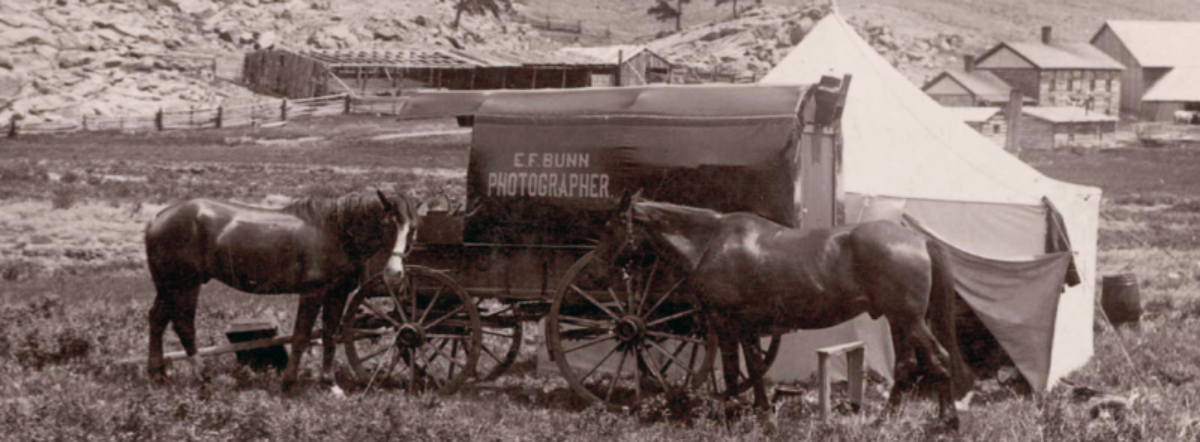
Last fall I attended the annual Daguerreian Society meeting in Boston, Massachusetts. I was on the lookout for photographs by Colorado photographers at the trade fair. An image made by Cronyn & Hibbs of a woman with a guitar caught my attention. I thought the name Cronyn was in my database, so I hustled up to my hotel room to check. (Note to self: Always ask the dealer to hold the photograph, rather than assume the photo will still be available when you return.)
My database included a William Cronyn, but no one named Hibbs. I liked the image and it provided information about Cronyn’s career trajectory, so I decided it would be a good purchase. I returned to the dealer’s table and the Cronyn photograph was in another collector’s hands. What should I do? I hung around as the woman contemplated her purchases, and exhaled a sigh of relief when she placed the Cronyn & Hibbs photograph in her reject pile. I immediately picked it up and asked the collector if she was sure she was willing to let this one go. We had a good chuckle about my predicament.
Cronyn’s biography is confusing. Canadian census data suggests that William Cronyn was born around 1850 in Ontario, Canada to David Cronyn and Anna Hawthorne Cronyn, but other records state his birthplace as New York. His personal life was messy. He married at least four times. Perhaps because of this, he moved frequently and his professional life showed plenty of challenges.
By 1879, William Cronyn lived in New York City. The 1880 census lists his occupation as a photographer and his wife’s name as Josephine. A year later, in March 1881, Cronyn married Etta Wright, in Omaha, Nebraska. They would remain married until the early 1890s. In the mid-1880s Cronyn was employed in the Pittsburgh area as an artist. Later in the decade, he opened a studio in Omaha, but ownership of the gallery ended up in court. Cronyn moved out of the gallery, taking all the apparatus and furniture, leaving broken negatives on the gallery floor.

In November 1887, Cronyn arrived in Pueblo, Colorado. The Colorado Daily Chieftain reported that Cronyn had “spent thirteen years…in the operating rooms of [Napoleon] Sarony’s famous photograph gallery in New York City.” Likely this is an exaggeration, as there is no record that Cronyn spent that length of time in New York.
He seemed to hit his stride in Pueblo. His wife assisted with studio sittings and ran the business when Cronyn traveled. She was also a talented artist, producing “point crayon” portraits. The point crayon portrait was executed by hand using only the point of the crayon, rather than the standard crayon portrait where shadows were created by rubbing the medium into the paper.

Cronyn claimed his studio had the largest skylight in Colorado, enabling him to make portraits even on cloudy days. The skylight aided him with his specialty for fancy lighting. He won first premium and a diploma for best photographic collection at the 1888 Colorado State Fair, held in Pueblo. Locally, his work could be seen in the windows of Pueblo’s Wick’s Shoe store.
Early on the morning of August 1, 1890, a newspaper carrier noticed a fire in Cronyn’s studio. An electric light left burning all night had ignited studio scenery. The firefighters saved the building but losses included the skylight, valuable backgrounds and studio apparatus valued at almost $2,500. The losses were fully covered by insurance and the studio was repaired quickly.
Less than a year later, another fire broke out in the back of the Cronyn studio, probably caused by the explosion of an oil stove. The studio suffered smoke damage and a few panes of the skylight broke. A week later Cronyn put the studio up for sale, including his cameras, chemicals, furniture, books and other supplies. Lydia McCloskey purchased the studio. Cronyn remained in Pueblo, working for photographer, Wesley S. Howard.
By late May 1891, E. E. Powers took over Cronyn’s former studio from McCloskey, with the operating room under the direction of Cronyn. The press referred to the business as the “Cronyn gallery.” Meanwhile, Mrs. Cronyn moved to Denver with their baby for her health. Cronyn joined his wife briefly in Denver, but news reports cited his interest in moving to Los Angeles, California or Missouri.
In June 1892, Cronyn secured a position with W. H. Caman in Wellington, Kansas, leaving his wife in Denver. A year later, Cronyn was on the road again. In 1896, he acquired a photo railroad car which he operated in North Dakota with someone named McGlachlin.
Cronyn’s third marriage took place in September 1898 in Minneapolis, Minnesota to Helen Gould, a young woman thirty years his junior. They divorced less than two years later due to Cronyn’s affection for another woman.

In 1899, Cronyn operated a rail car in Minnesota with Charles Hibbs. On July 5, 1900, misfortune struck Cronyn’s photo car. His assistant, who lived in the car, came home from a dance and accidentally tipped over a lamp, quickly igniting the entire car. The fire destroyed the car and all of its contents, valued at $6,000. Cronyn held only $2,000 insurance.
The 1900 federal census adds confusion to Cronyn’s biography. The census places Cronyn in Aiken, Minnesota, married to Margaret “Maggie” Whitney, also a photographer. The census data states that they have been married for 10 years. William Cronyn died of heart disease in February 1903 in Tracy, Minnesota.
Thank you to Dr. Marcel Safier, of Brisbane, Australia for researching Cronyn’s death date. Beverly W. Brannan, former curator of photography at the Library of Congress edited this post. Jori Johnson, Collections Access Coordinator and Keegan Martin, Digital Imaging Technician, History Colorado also assisted.
